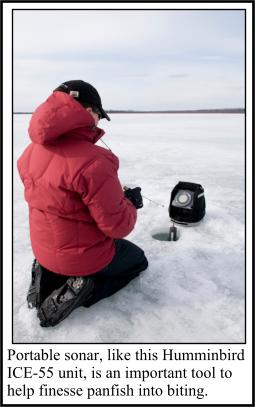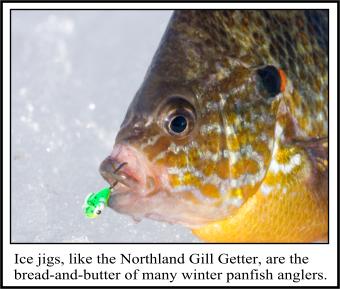|
IN THIS
ISSUE
SUBSCRIBE HERE!
Winter Panfish Toolkit?
By Tim Allard
Fishing Product Showcase
Three Tactics for More
Muskie!
by Pete Maina
Jig Fishing for
Largemouth Bass & Getting Hooked in the Hand
Facts of Fishing THE SHOW
Ice Fishing Cartoon
Northern Walleye Lodge
Dog Lake offers world-class fishing for Walleye, Northern Pike,
Smallmouth Bass, Lake Trout, Perch, and Whitefish with streams and
portage lakes that are stuffed with Brook Trout.
Frabill Worm Can
Sporting dual, top and bottom bait compartments, each sealed with a
watertight quarter-turn lid, the Crawler Can cools and can store two
different types of baits within a single can.
Winter Trout Tips
Early ice and last ice are absolutely the best times for
trout.
By: Tyler Dunn
Out of the Ice Age – Into the New
Age: Flashers are DEAD!
by Gary Parsons and Keith Kavajecz
Al Foss
Baits
3 Dimensional Fishing!!
Ottawa
River – Walleye or Sauger
By Lawrence Euteneier
Flowing past Canada’s Parliament
and threw our forth largest
city, Ottawa, the Ottawa River
may be one of Canada’s least
appreciated recreational
fisheries.
Get North - Ontario Fishing
Vacation Directory (New
site)
Search here for your next
awesome fishing trip!
Fishing Lodge Classifieds
Come fish your heart
out at one of these many Lodges, Camps and Resorts.
|

Ontario
Perch Fishing
Ontario
Fish Species
Bay Of
Quinte
Total Snowshoes
|
Winter Panfish Toolkit By Tim Allard*
The essential gear you need to ice panfish isn’t extensive. An
assortment of baits, a light action rod, and a good auger are the
key ingredients. Spicing up this menagerie are sophisticated tools,
such as electronics. These aren’t mandatory, but they’ll help you
catch more fish. The following items represent a well-rounded
toolkit for coaxing pannies topside.
Safety Gear
First and late ice offers incredible panfish action.
Generally speaking though, these book-end phases of winter are also
when ice quality and thickness is the least predictable. Your safety
should always take priority over biting fish. Carrying the following
safety tools is highly recommended. Ice picks help you pull yourself
from the water should you fall through the ice, while a flotation
suit or a PDF will keep you buoyant. A spud (chisel) is useful to
test the ice thickness in front of you as you walk. Lastly, boot
cleats provide traction on slick ice. '
 Drill Particulars Drill Particulars
A manual auger between 4.5- to 6-inches will serve you well
depending on your target species. Lightweight and inexpensive,
they’re also quieter than motor-driven models, a bonus for
shallow-water stealth. A power auger, however, is a luxury in thick
ice conditions and when punching 100-plus holes a day. If your
concerned about noise from power models spooking skinny-water
panfish, the whisper quiet Strike-Lite II from StrikeMaster Augers
will eliminate your worries.
Regardless of auger type, carry a supply kit containing: spare
blades and fastening screws, allen key, wrench, and an extra spark
plug for power augers. Remember to maintain your auger. If it fails,
the trip’s over unless someone nearby is willing to drill you a few
holes.
A Panfish Tool Belt
A lanyard’s a great accessory to keep important tools
within reach. Mine has a small file for sharpening hooks, a pair of
clippers for cutting line, and a LED light for charging glow baits.
It also holds removable forceps. These are less bulky than pliers
and better for removing tiny ice jigs from small-jawed panfish.
Remove or tuck the lanyard in your jacket when operating an auger as
having it dangling is dangerous.
Keeping Fingertips Toasty
Panfishing demands a lot of fine motor skill maneuvering,
like tipping a jig with maggots. It’s important to have fingertips
unhindered to complete these tasks, while still having a system to
insulate them so they don’t get cold and cramped. When fishing I use
flip-mitts or fingerless gloves and am a fan of Glacier Glove’s
fleece and neoprene models. Larger pair of mitts work well for
intense cold and when commuting between spots. Carrying spare gloves
is recommended. I also keep a fishing towel to dry off wet hands.
 Carriers and Windbreaks Carriers and Windbreaks
A container of some sort’s a must for transporting gear on
the ice. Options include a 5- to 6-gallon pail, a small ice fishing
sled, or a flip-over portable shelter. Sleds and buckets, which
double as seats, work well in mild conditions and when doing a lot
of walking and traveling light, such as late-ice perching. Portable
shelters shine in cold and windy conditions. Their tent fabric
creates a warmer interior when combined with a heater (make sure
your shelter’s properly ventilated to let fumes escape). They also
block wind from blowing ice fishing line, a bonus when finesse
fishing.
High-Tech Tools
For hard-core anglers electronics are indispensable. A GPS
loaded with a lake’s map data, such as that found on Navionics
HotMaps cards, lets you navigate to off-shore structures and return
to waypoints, like weed clumps. A portable sonar displays water
depth, your lure, and nearby fish. Interpreting the sonar gives
clues on a fish’s mood based on its reaction to the lure, letting
you experiment with jigging moves to pinpoint the perfect pattern to
trigger bites. An underwater camera has merit too, such as observing
panfish behavior, seeing the components of fish-holding habitat, and
learning jigging techniques for various baits. Murky water
conditions and snow cover will limit camera visibility, however.
A Range of Baits
Always carry a mix of ice baits. Small jigs with different
profiles (e.g., horizontal and vertical), puny plastics, and tiny
spoons and jigging minnows represent a healthy selection. Larger
lures
 let you quickly cover more water and attract fish. They
sometimes also appeal to bigger or more aggressive pannies. Smaller
ice jigs and plastics excel in finesse situations. Store baits in
small see-through trays or fly-fishing boxes, keeping them in your
outerwear pocket so they’re always within reach. let you quickly cover more water and attract fish. They
sometimes also appeal to bigger or more aggressive pannies. Smaller
ice jigs and plastics excel in finesse situations. Store baits in
small see-through trays or fly-fishing boxes, keeping them in your
outerwear pocket so they’re always within reach.
Balanced and Well-Stocked
Open-water tackle is rife with technique-specific rods and
this mindset has a place on the ice. A well-stocked rod case will
include a mix of ultra-light, light, and medium-light rods. The
golden rule of rod selection is using a balanced outfit that’s
sensitive enough to feel the bait, properly present the lure, and
detect faint hits. Use standard rods for larger lures and aggressive
jigging. Noodle or spring bobber models are better for finesse
jigging and signaling light or up-swimming strikes.
Micro spinning reels from reputable manufacturers are the choice for
trophy seekers given their quality components and superior drag
systems. Opt for 2- to 4-pound-test monofilament or fluorocarbon
ice-fishing specific line, matching line strength to lure weight and
target species.
Bait Containers
Live bait is critical to success on tough bites, whether
soaking a minnow for crappie or using a maggot-tipped jig for
sunfish. In winter, an insulated minnow bucket, like Frabill’s Kool
Keeper, is better than a plastic pail. An aerator will add oxygen to
keep minnows lively, and the circulation this creates delays water
freezing. For maggots and wax worms a StrikeMaster Bait Puck or
Lindy Grub Getter are good choices for carrying bait; keep the
container in an inside jacket pocket to prevent bait from freezing.
The above items represent a well-rounded panfish tool kit. Stick
with the basics to get started, but don’t be shy about integrating
specialized gear, like a power auger or a portable sonar, into your
panfishing search strategies. These sophisticated instruments will
help you ice more fish this winter.
*Tim Allard of Ottawa, Ontario is a hard-water expert and
author-photographer of the newly released book, Ice Fishing: The
Ultimate Guide.
Editors & Publishers
T.J. & Monique Quesnel
|
The
Ontario Fishing Network
E-Magazine is
published 12 times a year on or near the beginning of every month. Our
magazine is geared to any angler who enjoys fishing of any type in the
wonderfully diverse province of Ontario. Editorial Submissions: We welcome query letters,
but assume no responsibility for unsolicited materials. Subscriptions: Subscriptions are FREE of charge
and delivered via email.
You can subscribe
HERE: Privacy Policy: Unlike other publications We
NEVER make our subscribers list (your email address) available to any
other companies. Advertising: If you are interested in advertising
please email us. Circulation - 13,000 email subscribers
© 2011 Due North
Marketing / Ontario Fishing Network / T.J. Quesnel. All rights
reserved. Reproduction of any material without prior written
permission strictly prohibited. |
|